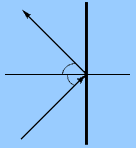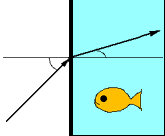Fish Tank Optics:
Learning How Light Travels
This lesson developed by Reach Out!
Recommended Ages: Early Elementary, Later Elementary, Middle
School
Guiding Question
- How does light travel? What happens when light
moves through or hits different materials?
Objectives
Concepts:
Light moves through or bounces off different materials in different ways
Principles:
- Light moves in waves
- Light waves can often travel through a material or medium
- When light waves hit a medium, light will either
reflect or refract
Facts:
- Light travels fast or slowly, depending on its power and on the material
it passes through
- Light moves more slowly through thicker and darker materials
- Light is reflected off of some materials
- Light is bent or refracted by some materials
- Light is absorbed by materials
- Light waves can scatter when they bounce off rough
surfaces.
Skills
- Observing
- Making Inferences
- Drawing Conclusions
Materials
- Different sizes of flashlights
- Fish tank filled halfway with water
- White and dark paper
- Large can or other nonfloating object
Room Preparation
Put fish tank on a table so students can stand around it, see, and do
experiments
Safety Precautions
No safety precautions necessary
Procedures and Activity
Introduction
How does light travel? What happens when light hits or moves through
different objects? Today, we will learn about light waves and see how they
travel. Light moves in waves, which can bounce off of or go through
materials.
Activities
- Have students shine flashlight beam through their hands. We can see that
flesh and bone won't allow light to pass through. Hand turns
pink—evidence that light is bouncing off. This bouncing of light off
a surface is called reflection.
- Shine flashlight beam through fish tank of water. Hold dark paper at
outside end of tank to see evidence that light is coming through the tank.
Look down into the water and see reflection in it. Experiment with
different sizes of beams and flashlights and document what you see.
- Put can or other object in the middle of the tank. Shine light through
tank and observe what happens when beam passes through water and hits
object. Do light waves pass through the object or bounce (reflect) off of
it?
- Next, place dark sheets of paper along the sides and end of the tank.
Focus a beam on the far end of the tank and observe how light shining in
at one end hits mostly, but not entirely, on the other end. Refraction
causes some light waves to bend and pass through the side walls.
- Shine light through air in tank. Observe that light has no reflection or
refraction because the medium is just “air,” so
there is no material to reflect or refract the beams.
Closing - Original Question
Ask again:
What happens when light moves through or hits different
materials?
Share what we have learned and observed.
Evaluation
Have students demonstrate, draw, or tell how light waves travel through air,
water, paper, glass, hands, etc. Listen for evidence that they understand
reflection and refraction.
Extension Ideas
- Have students try shining flashlight beams through other media—glass,
plastics, wood, cardboard, cloth—of different colors and thicknesses.
Have them record information about their observations. Do they see light
absorbtion or scattering?
- Shining light through a short length of fiber optic cable is great fun!
Give students a piece of fiber optic cable and a flashlight and let them
see how light can travel and be bent in any direction. Share how this is
useful in fiber optic applications such as communication (long-distance
signals that do not degrade) and medicine (minimally invasive exploration
of our internal organs).
- Try filling the fish tank (or a smaller glass container) with different
materials, such as vegetable oil, jello, milk, sand. Experiment and record
results.
- Try coloring the water in the fish tank with food coloring. Does light
travel differently through different colors of water? What if you use
different colors of light, too?
Careers Related to Lesson Topic
- Optical science and engineering
- Tour
the U-M Center for Ultrafast Optical Science
- Design of energy-efficient windows
- Environmental science and engineering
- Ophthalmology
- Optometry
- Scuba diving
- Underwater photography
Prerequisite Vocabulary
- Absorbtion
- Colored surfaces absorb some of the light that hits, scattering
other parts of the spectrum
- Light
- Behaves like waves with direction, amplitude, reflection, color, and
interference

- Medium
- A material or substance; in this experiment, see which media light
passes through and which it bounces off of
- Reflection
- The bouncing of light waves off of a surface

Refraction
- The bending of light when it passes through a substance; its deflection
from a straight path
- Scatter
- Rough surfaces have a complex surface that reflects light in all
directions
- Waves
- Light travels in waves, much as the water in the ocean moves in waves
Let us know what you think! E-mail our webmaster